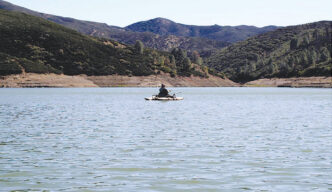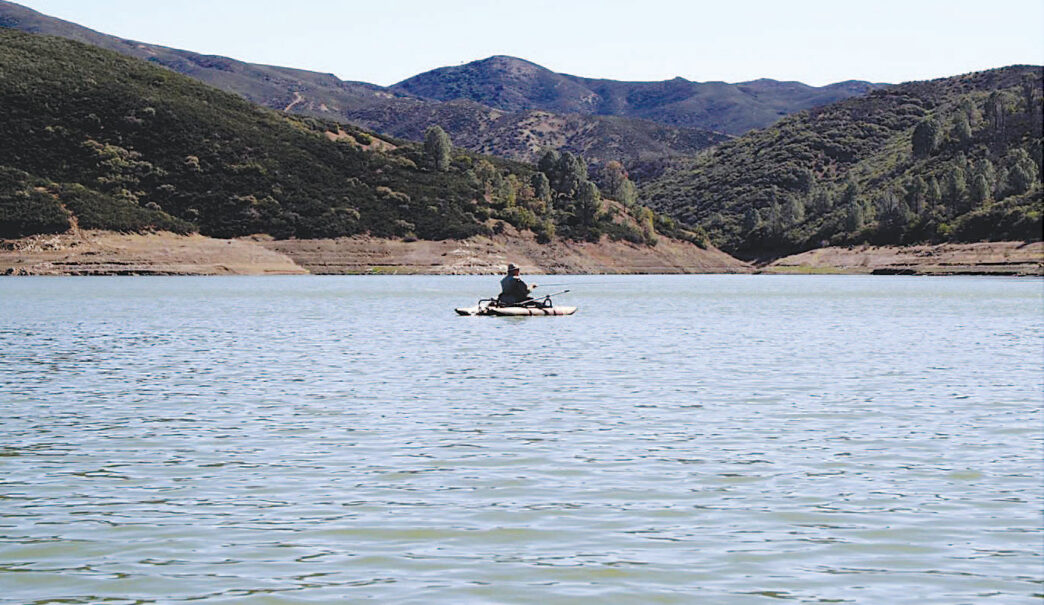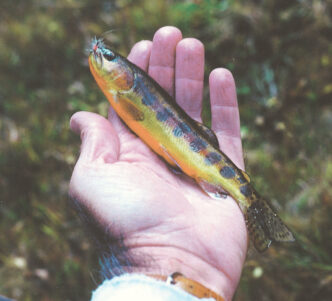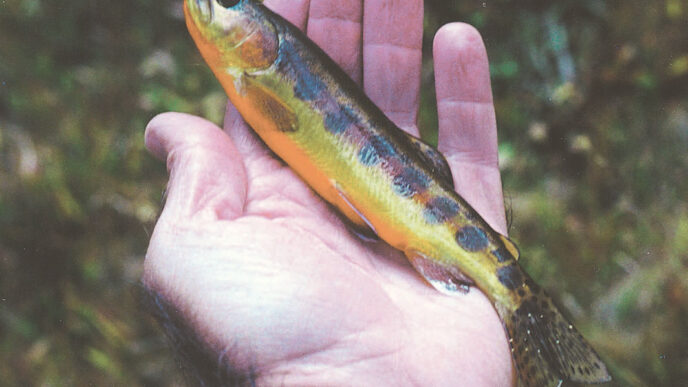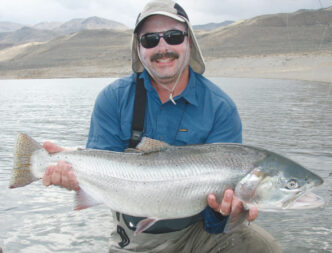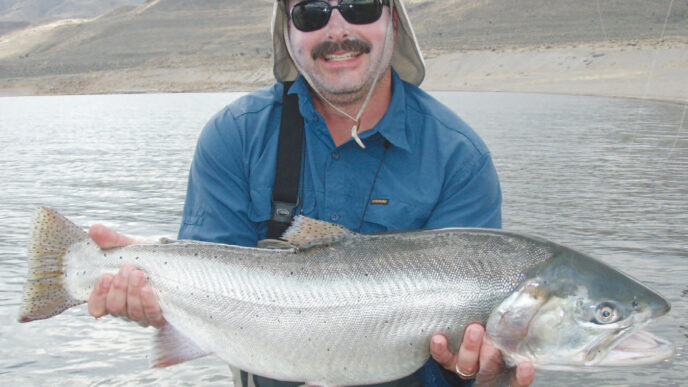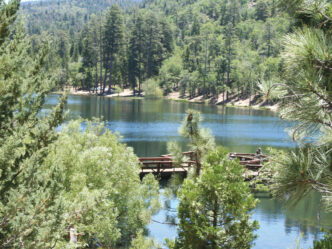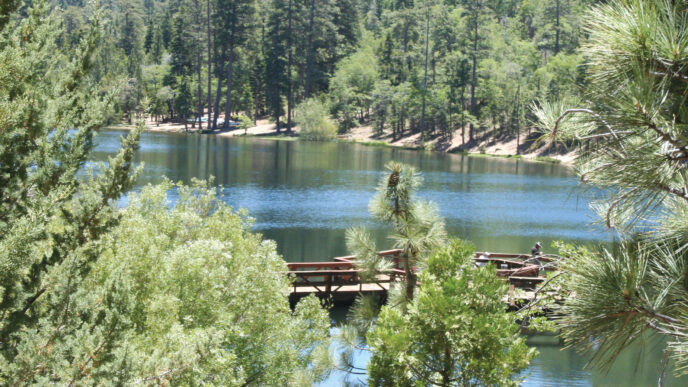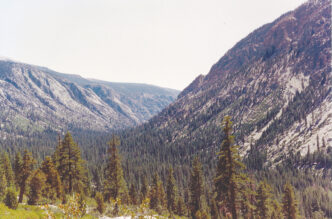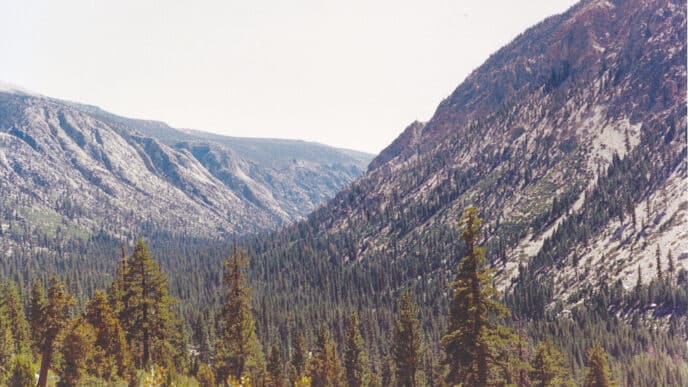In a way, Interstate 5 is purgatory for fly fishers, a long, usually hot and dry route that must be endured when traveling from Sacramento or the San Francisco Bay Area to trout waters in the Redding region. But although these are some of the best sport fisheries in the state, just west of I-5, nestled in the foothills of the Sacramento Valley, are four reservoirs that can offer good angling for fly fishers who might prefer to fish for a variety of species or who simply want to cut their drive short. Nicknamed “The Fabulous Four,” these impoundments — Indian Valley Reservoir, Black Butte Lake, Stony Gorge Reservoir, and East Park Reservoir — hold largemouth and smallmouth bass, trout, crappies, and bluegills, and are open throughout the year for angling.
The reservoirs were constructed for irrigation to grow citrus, rice, and corn in the rich valley soil. The area’s farmers took a huge risk and put many of their own financial holdings up for collateral to have the system built. The federal government, under the Reclamation Act of the early 1900s, constructed the dams to form the several reservoirs and the vast water-delivery system that makeup what is called the Orland Project. Construction began in 1927 with the East Park Reservoir Dam on Stony Creek, and the project’s last reservoir, Black Butte Lake, was completed in 1963, also by damming Stony Creek. The construction of Indian Valley Reservoir was backed by wealthy Yolo County farmers to irrigate farmlands and aid in flood control. It’s not part of the Orland Project.
The first time I fished one of these reservoirs, I was in high school. My buddies and I drowned hot dogs at Black Butte Lake for catfish. Fishing was the least of our interests. Usually it was an opportunity to get away from our parents, drink beer, and tell lies. It was a great time. The first occasion I actually fly fished one of the reservoirs was when I was in college. I fished Black Butte Lake with two friends and mentors, Richard Brown and Walton Powell.
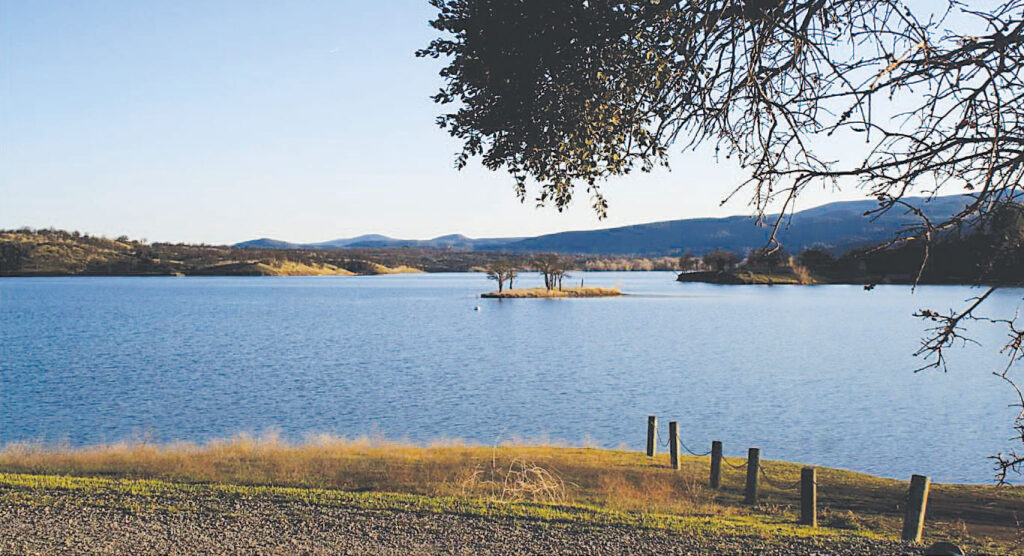
It was in the spring, and the crappie bite was just getting started, but the wind picked up from across the lake and the bite slowed down significantly after we’d caught a couple of fish. Richard and Walt grew frustrated, and Walt changed tactics. He took off the small jig fly that he had been fishing and tied on a Green Death shad fly. Then he fumbled around with a bottle filled with white pork rind strip bait. He attached a strip of the pork rind to the fly and cast. Bam — fish on. Richard and I changed over to the combination.
It cost me, though. I had no shad flies, so Walt sold me a fly — which I had tied for him — for two bucks. He threw in the pork rind for free. He laughed and said, “Boat prices!” To this day, every time I fish one of these lakes, I remember Walt Powell and those two bucks.
Getting There
Indian Valley Reservoir is the farthest south of the Fab Four. In 1975, the North Fork of Cache Creek was dammed, creating an impoundment six miles long and one mile wide with approximately 3,800 surface acres and 41 miles of shoreline. Indian Valley Reservoir is located 27 miles west of Williams, off Highway 20 in the Indian Valley Wildlife Area managed by the federal Bureau of Land Management. Walker Ridge Road connects Highway 20 and the lake. It is a gravel road running through chaparral and buck brush. The road forks, with one fork leading north, around the east side of the lake, and the other leading to the south shore by the dam. The lake has limited accessibility for boats, with a ramp located at the dam and another ramp located on the north shore. With so many miles of shoreline, an angler has plenty of space to fish. If you intend to use a boat, Indian Valley Reservoir has a 10-mile-per-hour speed limit on the main body of the lake, with a 5-mile-per-hour speed limit along the shoreline.
This impoundment seems designed for fly fishing. The best and most consistent angling for trout is at the dam and on the west side of the lake, which holds the original creek bed. Along with the trout, you’ll find largemouths, smallmouths, crappies, bluegills, and other sunfish. All are willing to eat flies.
East Park Reservoir is located north of Indian Valley Reservoir, 23 miles from the city of Maxwell. The impoundment holds 1,820 surface acres of water at capacity, creating 25 miles of shoreline. It has no improved boat ramps. The lake is easy to reach. Take the Maxwell-Sites Road (the main exit for Maxwell on Interstate 5) for 23 miles west-northwest. You can also travel from Elk Creek south on County Road 306 to the town of Stonyford. The lake is located just east of that foothill township, with the road to the lake being well-marked. The impoundment is on your northwest side. Campground Road runs along the east side of the lake and has multiple areas where you can park near the water’s edge. East Park Road allows access to the west side of the lake. East Park Reservoir holds hatchery-raised rainbow trout, a variety of panfish species, and bass.
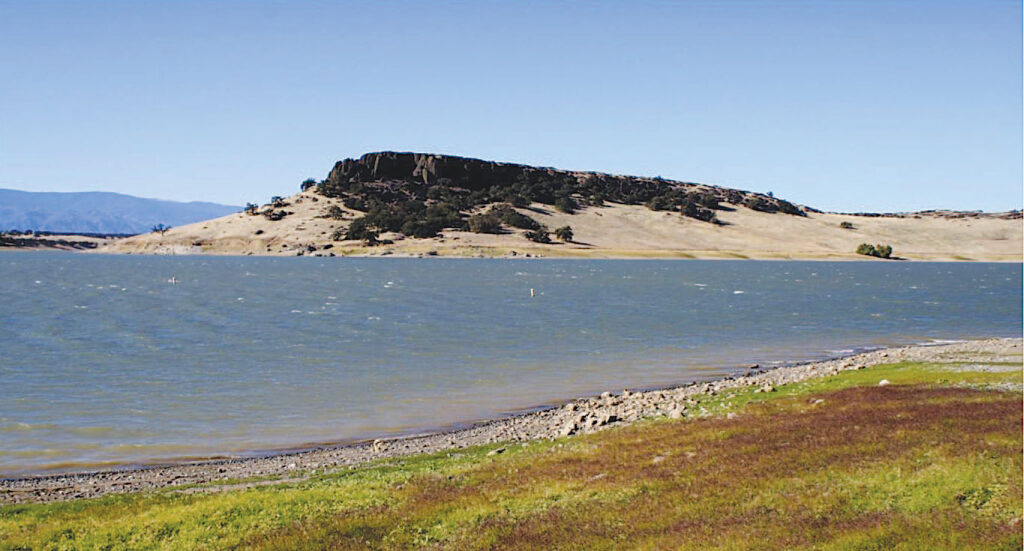
To the north lies Stony Gorge Reservoir. This 1,275-surface acre reservoir was also formed by damming Stony Creek. It has 11 miles of shoreline and one boat ramp, and is located 20 miles west of my hometown of Willows. Take the Highway 162 exit from Interstate 5 and travel west toward the town of Elk Creek. The road to Stony Gorge is marked with a sign. Turn south on the road and drive about two miles. The lake will be on your right. As its name suggests, the lake sits in a gorge, and when water levels are high, the water spills over into the flat terrain on the east side of the lake. It has been rumored (I haven’t confirmed this) that the lake holds the Texas strain of largemouth bass. The bass that I have caught at Stony Gorge mostly have been largemouths — on average, fish from a pound to three pounds. The lake also has crappies and bluegills. There are plenty of great areas to fly fish. County Road 304 runs along the lake on the east side for a good distance.
North of Stony Gorge is Black Butte Lake, the largest of the four impoundments. This huge body of water is located eight miles west of the small community of Orland. The lake is 7 miles long, with more than 40 miles of shoreline, and has a surface area of 4,460 acres. Because of this size, you will find multiple boat ramps. It is a shallow lake, however, and water temperatures soar in the summer. For the best fly fishing, look for coves and areas with wood or lily pads. The lake offers many access points. The Grizzly Flat and Burris Creek access areas are ideal for fly fishers.
The miles of shoreline at the Fab Four impoundments contain coves, rock ledges, and rocky points that all hold fish and that are just waiting to be explored. Warmwater species can be found in the shallower water around structure and overhangs. Trout are found in cooler, deeper water, and water temperature is the main factor when targeting trout at these lakes. The best seasons for fly anglers to hook trout are winter, fall, and spring, when water temperatures are low. Although warmwater species can be caught throughout the year at all of these lakes, the spring is when many anglers target panfish and bass. These fish congregate in the shallows to prepare for spawning and they usually are aggressive and are feeding heavily.
These lakes can offer fly fishers a great angling experience all year long, with miles of shoreline for anglers to explore and the opportunity to cast poppers to waiting bass or panfish on a summer night and to cast Woolly Buggers to trout in the late winter in balmy 65-degree weather. They’re truly fisheries worth visiting.
Fishing the Fab Four
For fishing subsurface patterns, I like a standard 9-foot to 10-foot 5-weight or 6-weight rod with an intermediate line. For subsurface work, fish short leaders, 3 to 5 feet long, tapered to 2X to 5X tippets, although using a leader tapered to 5X for bass can be pushing the light-tackle envelope. For trout, when the fishing gets tough, you can use a longer, 7-1/2 foot 5X leader. I like the countdown method for getting my flies into the zone where fish are feeding.
Productive subsurface streamer patterns for bass include standard Conehead or Beadhead Woolly Buggers, size 6, Dan Byford’s Zonker in pearl and white or silver and gray, size 6, Milt’s Pond Smelt, size 6, and Trent Pridemore’s version of Tom Nixon’s Calcasieu Pig Boat, size 2 (see the recipe below). Bead-chain or machined eyes can be added to enhance weight and action, and adding weed guards to subsurface bass flies is a must.
Subsurface patterns for trout include Woolly Buggers in olive, sizes 6 to 8, J. Fair’s Wiggle Tail in olive or black, size 10, Hogan Brown’s S&M Nymph in olive, size 16 to 18, Gray’s X-May in olive, size 16 to 18, and Tiger Midges in black or red, size 18 to 20.
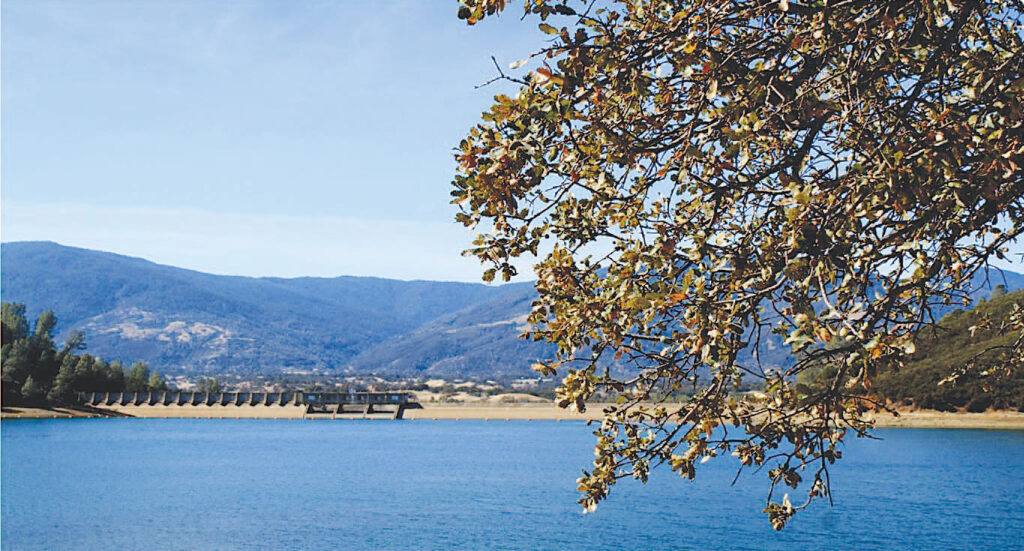
For surface work, you can use the same rod with a floating line, but a line with a taper that can turn over wind-resistant poppers and the indicators that are fished with nymphs and midges is a big help. Leaders can range from 9-1/2 feet to 12 feet. If you really get into fishing large poppers, you may want to add a dedicated bassin’ fly rod and line to your arsenal. Either way, use short leaders for larger poppers and longer leaders for smaller poppers. Bass surface patterns include Milt’s Firetiger Minnow, size 2/0, Milt’s Perchy Baby, size 2, the Umpqua Swimming Frog and the Solitude Froggy, size 2, the Solitude Bream-Sting, size 12, the Solitude Mini Froggy, size 6, Lance’s Crystal Popper, size 3/0, in white and black, and Lance’s Jr. Popper, size 2/0.
Trout surface flies include the Adams Parachute, size 14 to 18, flying ant imitations, size 10 to 12, and grasshopper patterns, size 6.
Don’t worry, by the way, if you don’t have these patterns — part of the enjoyment of fly fishing is experimenting with what you have.
When fishing surface bugs for bass, try the “shadow popper” technique. Tie a subsurface fly such as a Woolly Bugger or nymph to the bend of the popper’s hook, 24 inches back. The fly will ride below the popper, and the commotion made by the popper will draw fish, with 90 percent of strikes coming on the trailer or “shadow” fly. Any popper can do the job — the trick is to match the size of the popper with the size and weight of the streamer or nymph. A popper that sinks is not going to allow the system to work. The shadow popper technique works best when using a short 3 feet of 0X leader from the fly line to the popper and then another 2 feet of 3X leader from the popper to the shadow fly. If you are fishing small poppers with small trailing flies, extend the main leader to 6 feet, tapered to 3X, with a 2-foot section of 5X. Go fish.
Trent’s Calcasieu Pig Boat
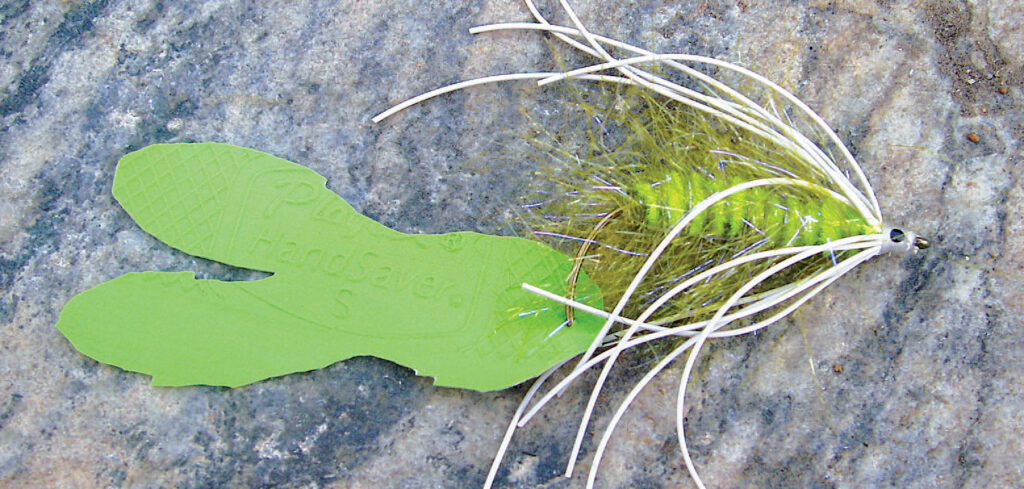
Hook: TMC 8089 or TMC 8089NP (or other wide-gap bass popper hook)
Thread: White Danville 3/0 monocord
Weed guard: .025-inch monofilament
Eye paint: Two contrasting acrylic paints, such as black and red
Finish: Clear Sally Hansen’s Hard as Nails nail polish
Weight: .025-inch lead-free wire, 20 wraps
Body: Chartreuse, white, or black polar chenille
Skirt: Jig body material, black or white rubber legs
Tail: Dental dam material, color and cut to suit
Step 1: Wrap the hook shank with layer of thread, then wrap 20 turns of .025inch lead-free wire on the upper two-thirds of the shank and cover the wire with thread. Tie in the .025 monofilament weed guard behind the eye and along the shank, back to the bend of hook.
Step 2: Tie in the chenille behind the lead-free wire and back along the shank to the hook bend. Wind it all the way forward, making a tight body. Tie it off at a quarter of an inch behind the eye.
Step 3: Cut two bundles of six rubber strands each. Tie in one bundle behind the hook eye on the right side of the hook shank and repeat on the left side of the hook. The rubber strands should extend half an inch beyond the hook bend.
Step 4: Bring the monofilament weed guard around to the eye, tie it off, and clip the excess. Form a thread head and coat it with Sally Hansen’s nail polish. Then paint the two-tone eye. Let this dry and apply another coating of nail polish.
Step 5: The tail is a “pork rind” trailer made from dental dam rubber. Design a trailer pattern template with paper in the shape you would like: frog, lizard, or even a baby snake. Lay the template on the dental dam material and trace the shape, then cut it out. You can add dots or highlights with permanent markers. Google “dental dam material” for sources. Multiple colors and thicknesses are available, with “thin” being the best thickness for this application.
If You Go…
All of these lakes are popular with water-sports enthusiasts — boaters, waterskiers, and jet skiers — but they’re also large enough to let you find areas that have less traffic. Be aware, however, that you are not likely to be alone on the water. Take steps to be safe. When fishing these lakes from a boat or other watercraft, make sure you wear bright clothing and a personal floatation device. When staying out on the lake past dark, carry a flashlight or, better yet, multiple lights so boats can see you and for you to see what you’re doing. Fishing safe is fishing smart.
The California Department of Fish and Game regulations for these lakes can be found at http://www.dfg.ca.gov.
Indian Valley Reservoir’s GPS coordinates are 39.0804°5N 122.5347°W. For maps, access, and other information, go to anvalley.html and http://www.blm.gov/ca/st/en/fo/ukiah/indianvalley.html.
East Park Reservoir’s GPS coordinates are 39.3575°N 122.51472°W. For maps, access, and other information, go to
http://www.usbr.gov/mp/ncao/eastpark/docs/EPbrochure.pdf.
Stony Gorge Reservoir’s GPS coordinates are 39.587467° N 122.525325°. For maps, access, and other information, go to
www.paddlingcalifornia.com/Stony_Gorge_Reservoir.html.
Black Butte Lake’s GPS coordinates are 39.4821°N 122.2128°W. For maps, access, and other information, go to
http://www.fishersnet.com/images/lakemaps/black.gif and http://corpslakes.usace.army.mil/visitors/projects.cfm?Id=L201600.
Choices for dining and lodging are plentiful in the area. From Italian restaurants to plain home cooking, you will find it all around the lakes and up and down on Interstate 5. See “The Foraging Angler” in this issue for suggestions.
There are multiple hotels and motels in every town. Two hotels that visiting anglers have enjoyed in the past are Granzella’s Inn, at 391 Sixth Street in Williams, www.Granzellas.com, (530) 473-3310, and Holiday Inn Express, at 545 Humboldt Avenue in Willows, www.hiexpress.com, (877) 786-9480.
For anglers wishing to camp, every lake has camping areas. Some are primitive, and others have flush toilets to full hookups. For information on camping go to http://corpslakes.usace.army.mil/visitors/projects.cfm?Id=L201600, for Black Butte; http://www.usbr.gov/mp/ncao/eastpark/docs/EPbrochure.pdf, for East Park; http://www.blm.gov/ca/st/en/fo/ukiah/indianvalley.html, for Indian Valley; and http://www.recreation.gov/unifSearchResults.do?topTabIndex=Search, type in “Stony Gorge” for Stony Gorge.
Lance Gray



